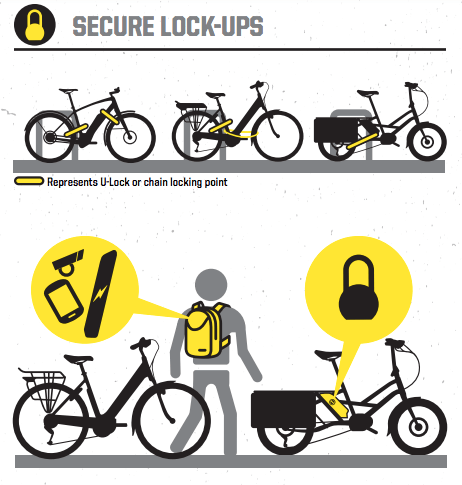We purchased two new Bulls Cross Lite hybrid bikes by following the tips on buying an e-bike. While looking forward to getting many years of enjoyment from them, the purchase has me thinking about how to protect against bike theft.

Bike Theft is a Reality
It is difficult to get an accurate number of annual bike thefts in Canada or the US. One estimate indicates there are around 2 million bikes stolen per year in the US. This is only an estimate as many bike owners don’t report thefts – fewer than 1 in 5 bike thefts are reported. Even more worrisome is the fact e-bikes are three times more likely to be stolen than regular bikes.
Is there any good news to protect yourself against bike theft?
There is. While keeping your e-bike safe is not guaranteed, there are some practical steps you can follow to protect your e-bike investment and reduce the risk of becoming a victim of bike theft.
Who is stealing bikes?
Two distinct types of bike thieves can be identified:
- Amateur/Opportunist
- Dedicated thief
The Amateur/Opportunist is likely someone who steals a bike for a lark or simply as disposable transportation. They aren’t particularly sophisticated nor driven by profiting from the theft. If a bike is unlocked and easily taken, it is. Unfortunately, there also is minimal risk of getting caught. In many cases, bikes are dumped after being stolen making it possible to recover your bike. If you have registered your bike as suggested below, there is a reasonable chance your bike will be returned to you.
The Dedicated thief is much more sinister and appears to be a greater threat to your goal of keeping your e-bike safe. They are looking for opportunities to steal bikes to generate income. Most worrisome is that they have developed techniques to quickly steal bikes from a variety of locations. And in many places bike theft is not a high priority for police which means the risk of being caught is often pretty low.
The following video produced by the City of London police highlights how quickly a dedicated bike thief can overcome basic bike locks.
Is there any good news?
Yes.
There are several strategies you can follow to help protect your e-bike investment. Some will reduce the risk of having your e-bike stolen while others will help you recover a stolen bike or financially compensate you. No one strategy is foolproof but together they can help protect your e-bike investment.
1. Register your bike
There are several free, online services to register your bike including Bike Index or 529 Garage. If it is stolen, the information provided can be shared with local police and used to monitor online markets (Facebook Marketplace, Kijiji, and CraigsList) where stolen bikes are frequently sold.
While not a guarantee your stolen bike will be recovered, these organizations are successful in recovering bikes in many cities. For example, Vancouver experienced a sharp decline in bike thefts with the introduction of 529 Garage.
Across Vancouver, the number of bike thefts fell 20% in the first year the pair worked together. The next year, they fell another 30%. On Granville Island in June 2015, before the project started, 33 bikes were stolen. In June 2017, that number had fallen to seven
Excerpt from The Guardian, November 7, 2017
But the real benefit of registering your e-bike is access to a central database with key information about your bike – serial number, description and photos. This information is needed to reclaim your bike or used for an insurance claim but many bike owners don’t keep adequate records. Reports by Calgary police indicate that as many as half of the stolen bikes are recovered yet only about 12% are returned to owners. They simply don’t have a record of their bike that can be used to verify ownership.
2. Lock your bike
I follow several e-bike forums that provide insights on current issues of concern to e-bike owners. Of course, protection against theft of their e-bike is a primary concern. And so it should be. Protecting your e-bike investment of several hundreds or even thousands of dollars is part of the deal in owning an e-bike.
Yet there remains a cavalier approach to e-bike security. A lot of money is spent on the bike but not on protecting it. As the previous video highlights, using an inexpensive lock doesn’t do much to protect your e-bike.
There are two important steps required in securing your e-bike:
1. Buy high quality locks
While there is no hard and fast rule, spending up to 10% of your bike’s value is reasonable. This actually isn’t very difficult as it is advisable to use two different locks- one for the front wheel and one for the rear wheel.
There are lots of online resources to help you determine which lock manufacturer and lock type you should choose. One of the best resources I have found is the Best Bike Lock website to help evaluate locks and identify best choices. Both Abus and Kryptonite are leaders in terms of quality and effectiveness.
I have bought Kryptonite U-Locks and the Abus chain lock to protect our e-bikes.
The BikeFare website does a nice job of explaining two common bike lock rating systems – Sold Secure and ART. There also is guidance on how to choose the right lock for you based on assessing your local risk factors.

This photo highlights a reality, bike thieves will take advantage of any weakness. This can be where you lock your bike or how you lock it.
Bike Rack Issues
As you become more aware of the need to protect your e-bike, you also become more aware how awful many of the public bike racks are. Often they aren’t bolted to the ground or don’t allow you to lock the whole frame to the rack. And even if they are of decent quality, they are located in an obscure location out of public sight. Perfect for a bike thief to take their time to cut through your lock.
Collectively, we need to be demanding that local governments strengthen their standards for bike racks. This would be both for the type of rack and the requirement to provide more racks at all public locations.
Using locks to stop bike theft

Until then, the challenge is to find something to lock your bike to. Ideally this should an object that is secured to the ground, not easily cut through and not blocking pedestrian traffic. When available, a secure bike rack is the best option especially if you only have a U-lock.
Again, depending on what you have available to lock your e-bike to, it is advisable to use two locks. The first is to lock your front wheel to the bike frame and to the object you are locking to. In many cases, a chain or folding lock works best.
The second lock secures your back wheel to the frame and, where possible, to the bike rack or whatever you are using to secure the bike.
The objective is to increase the difficulty for a potential thief, increase the amount of time/effort required, and have them move on.

The downside of using two locks is the extra weight that they add to your ride. As well, there is the inconvenience of managing two locks. Locks from Abus can keyed so that all locks including the lock for your bike battery are one key. However, there is a charge for each lock and many retailers don’t know how to get the locks rekeyed. Seems to be more marketing spin than a real solution.
An increasing number of Bluetooth compatible locks are becoming available. It’s not clear yet if the locking mechanisms for these locks are as good as traditional keyed locks.
One thing is very clear though – stay away from cable locks as they offer no protection and provide a false sense of security.
Home and bike carrier security
Much of the focus above is on how to secure your e-bike while you are out riding. However, two additional important considerations are how your e-bike is protected both at home and while being transported.
The reality is that most bikes of all types are stolen from the owner’s home. Whether it is an open garage door, unlocked shed or a bike left in the side yard. So it is important to lock your e-bike even when it is sitting in your garage or in a shed in your backyard. As always, the objective is to make it difficult for someone to simply hop on your bike and ride away.
The same mindset applies when you transport your e-bike. When you stop for a quick bite or to grab some groceries for your camping trip, consider how easy it would be to remove your e-bike from your bike carrier. If you use a chain lock, consider using it to lock your bikes to the bike carrier in addition to any locks included with the carrier. Bike carriers such as the Thule XT2 Pro have a lock for the hitch to prevent the carrier and bikes being removed.
Removing the battery will also make the bike less desirable. It also reduces the chance your battery comes off while travelling down the highway. The last thing you want to see in your rear view mirror is your battery lying in the middle of the road.
3. Get insurance
Assuming you have registered your bike and you are diligent about locking it both at home and when you are riding, there still is a chance your bike will be stolen.
The last strategy to protect your e-bike investment is to insure it. Many homeowner or renter insurance policies provide coverage against theft and even liability. The amount of coverage varies by insurer so it is important to check with your insurance broker or insurer to determine what coverage is offered, the deductible available and any restrictions to the coverage. When I checked our coverage, one of the limitations was the bike had to fall within the legal definition of e-bikes in Canada. This means no throttle and maximum 500 watt motor.
As well, you may be able to put on a special rider for your e-bike even if it isn’t covered under your main policy.
There are specialty insurers that will cover e-bikes. While the cost may seem high, it is worth investigating to recoup your investment in your bike.
Owning an e-bike offers a lot of enjoyment and recreation value. However, being aware of the risk that your bike can stolen and finding ways to mitigate this risk will help protect your e-bike investment.
If you have had your e-bike stolen, what would you do differently to protect it? As well, what steps do you take to protect your e-bike?

Thank you for your article and the links to a couple of also very good articles. One thing you did not cover was disc brake lock/alarms. Would please give me your opinion on the effectiveness of these devices.
Thank you
Fred Tot
Thanks for your question, Fred. In my research I didn’t find any mention of this type of lock/alarm. I’ll research this further and let you know what I find out.